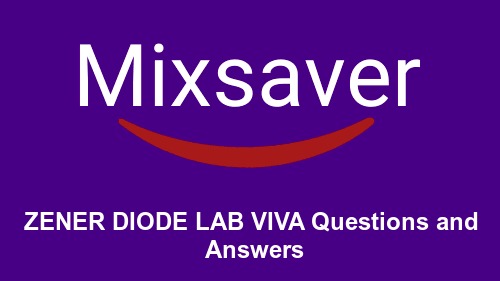1. What is a zener diode?
Zener diode is a p-n junction diode specially designed for operation in the breakdown region in reverse bias condition.
2. Define what is zener voltage?
The voltage at which the zener diode breaks down is called the zener voltage.
3. What is meant by the temperature coefficient?
The effect of temperature on zener voltage is given in terms of temperature coefficient which is defined as the percentage change in nominal zener voltage for each degree centigrade of change in junction temperature.
4. Define what happens to the series current , load current and zener current when the dc input voltage of a zener regulator increases?
Zener current and series current increases while the load current remains unchanged.
5. Why is zener diode used as a voltage regulator?
Zener diode has the property of behaving like a dc battery in ‘on’ state (i.e. when the voltage across the zener diode exceeds its zener voltage rating VZ) . In ‘on’ state , the voltage across zener diode remains constant until the voltage across it deops less than VZ . This property of zener diode makes its use as a voltage regulator.
6. Explain how zener diode maintains constant voltage across the load?
Zener diode has the property of behaving like a dc battery in ‘on’ state. If the zener diode is shunted across the load RL and the voltage across zener diode is more than the zener voltage VZ then zener diode is on ‘on’ state , and any variation in voltage across the zener diode due to variations either in supply voltage or in load resistance is not able to change the output voltage. Thus zener diode maintains voltage constant across the load.
7. What is the basic principle of zener diode?
Zener breaks down
8. What is zener break down?
When a diode is heavily doped, it’s depletion region will be narrow. When a high reverse voltage is applied across the junction, there will be very strong electric field at the junction. And the electron hole pair generation takes place. Thus heavy current flows. This is known as Zener break down.
9. Mention any application of zener diodes
In voltage regulators
10. Zener diodes are also known as
a) Voltage regulators
b) Forward bias diode
c) Breakdown diode
d) None of the mentioned
Answer: c
Explanation: Zener diodes are used as voltage regulators but they aren’t called voltage regulators. They are called breakdown diodes since they operate in breakdown region.
11. Which of the following is true about the resistance of a Zener diode?
a) It has an incremental resistance
b) It has dynamic resistance
c) The value of the resistance is the inverse of the slope of the i-v characteristics of the Zener diode
d) All of the mentioned
Answer: d
Explanation: All of the statements are true for the resistance of the zener diode.
12. Which of the following is true about the temperature coefficient or TC of the Zener diode?
a) For Zener voltage less than 5V, TC is negative
b) For Zener voltage around 5V, TC can be made zero
c) For higher values of Zener voltage, TC is positive
d) All of the mentioned
Answer: d
Explanation: All of the mentioned are true for the TC of a zener diode.
13. Which of the following can be used in series with a Zener diode so that combination has almost zero temperature coefficient?
a) Diode
b) Resistor
c) Transistor
d) MOSFET
Answer: a
Explanation: If a Zener diode of TC of about -2mV is connected with a forward diode (which has a TC of about +2mV) in series, the combination can be used to obtain a very low (close to zero) TC.
14. In Zener diode, for currents greater than the knee current, the v-i curve is almost
a) Almost a straight line parallel to y-axis
b) Almost a straight line parallel to x-axis
c) Equally inclined to both the axes with a positive slope
d) Equally inclined to both the axes with a negative slope
Answer: b
Explanation: Note that the curve is v-I curve and not an i-v curve.
15. Zener diodes can be effectively used in voltage regulator. However, they are these days being replaced by more efficient
a) Operational Amplifier
b) MOSFET
c) Integrated Circuits
d) None of the mentioned
Answer: c
Explanation: ICs have been widely adapted by the industries over conventional zener diodes as their better replacements for a voltage regulators.
16. A 9.1-V zener diode exhibits its nominal voltage at a test current of 28 mA. At this current the incremental resistance is specified as 5 Ω. Find VZ0 of the Zener model.
a) 8.96V
b) 9.03V
c) 9.17V
d) 9.24V
Answer: b
Explanation: VZ = VZo + MZ IZT
9.1 = VZo + 5 * 28 * 10-3
VZo = 8.96v
VZ = VZo + 5IZ = 8.96 * 5IZ.
17. A shunt regulator utilizing a zener diode with an incremental resistance of 5 Ω is fed through an 82-Ω resistor. If the raw supply changes by 1.0 V, what is the corresponding change in the regulated output voltage?
a) 72.7 mV
b) 73.7 mV
c) 74.7 mV
d) 75.7 mV
Answer: c
18. A designer requires a shunt regulator of approximately 20 V. Two kinds of Zener diodes are available: 6.8-V devices with rz of 10 Ω and 5.1-V devices with rz of 30 Ω. For the two major choices possible, find the load regulation. In this calculation neglect the effect of the regulator resistance R.
a) -30mV/mA and 120mV/mA respectively
b) 30mV/mA and 60mV/mA respectively
c) -60mV/mA and +60mV/mA respectively
d) -30mV/mA and -120mV/mA respectively
Answer: d
Explanation: Three 6.8v zeners provide 3*6.8 = 20.4v with 3 * 10 =30? Resistance, neglecting R, we have
load Regulation = -30mV/mA.
For 5.1 Zeners we need 4 diodes to provide 20.4v with 4 * 30 =120? Resistance.
load Regulation = -120mV/mA .
19. Partial specifications of a Zener diode is provided. VZ = 10.0 V, VZK = 9.6 V, and IZT = 50 mA. Assuming that the power rating of a breakdown diode is established at about twice the specified Zener current (IZT), what is the power rating of each of the diodes described above?
a) 1.04 W
b) 0.104 W
c) 10.4 mW
d) 1.04 mW
Answer: a





